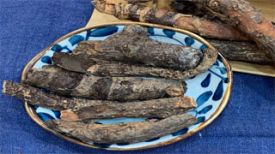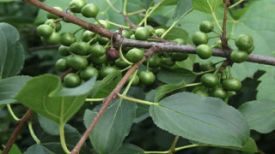1. Nickname: End drug.

Low shrubs or trees, about 3 meters high. The trunk is thick, with many irregular sharp branches, and the bark is thin, smooth, with small flakes peeling off, light orange brown, and later turning gray. The leaves are scattered or clustered, with single or triple compound leaves. The small leaves are oblong ovate or oblanceolate, and the central one is 7-18 millimeters long and 4-5 millimeters wide, much larger than the pair on both sides. The head is blunt, and the entire edge or end is slightly serrated. The flowers are small, clustered on short branches, calyx cup-shaped, persistent, with 4 blunt teeth on top. The corolla is white, with 4 petals, elongated or linear, upright. The stamens are 8, extending from the edge of the short cup-shaped disk, upright, unequal in length. The ovary is 3-chambered, the style is short and thick, and the stigma is head shaped. Drupe ovoid, pointed, smooth, brown, with a leathery or fleshy outer skin. 1-3 seeds, but only 1 mature and the rest shrink. The flowering period is summer.
3. Origin distribution
Produced in Somalia, Ethiopia, and the southern Arabian Peninsula.
4. Harvesting and processing
Harvest from November to February of the following year. Resin can naturally seep out from cracks in the bark, or cut the bark to allow the resin to seep out from the wound. Initially appearing as a light yellow white viscous liquid, it gradually solidifies into a reddish brown hard lump when exposed to air. After harvesting, remove impurities and store in a dry and ventilated place.
5. Characteristics of medicinal herbs
1. Natural Myrrh: Irregular granular masses of varying sizes, with larger ones having a diameter of over 6 centimeters. The surface is yellow brown or reddish brown. The semi transparent part is brownish black and covered with yellow dust. The texture is firm and brittle. The broken surface is uneven and lacks luster. Has a unique aroma, with a bitter and slightly pungent taste.
2. Gelatin myrrh: It is irregular in shape and particles, often sticking into clumps of varying sizes, with larger ones having a diameter of more than 6 centimeters. The surface is brownish yellow to brownish brown, opaque, solid or loose in texture, with a specific aroma, a bitter and sticky taste.
6. Nature, taste, and meridian tropism
Mild in nature, with a spicy and bitter taste. Guixin Meridian, Liver Meridian, and Spleen Meridian.
7. Effect and function
Dispelling blood stasis and relieving pain, reducing swelling and promoting muscle growth. Belonging to the category of blood activating and blood stasis resolving drugs, it is a blood activating and analgesic drug.
8. Clinical applications
Internal administration: decoct soup, dosage 3-10 grams, or add into pills or powder. External use: In moderation, apply after grinding. Used for chest pain, epigastric pain, dysmenorrhea and amenorrhea, postpartum stasis, abdominal pain in the affected area, rheumatic pain, injuries caused by falls and bruises, and abscesses.
9. Pharmacological research
Similar to other oily resin substances, myrrh (usually used as a tincture) has certain local irritant effects and can be used in oral cleansers or to stimulate intestinal peristalsis in cases of gastrointestinal weakness. The water infusion has an inhibitory effect on skin fungi such as Trichophyton violaceus using a test tube dilution method with a ratio of 1:2. The volatile oil contained has a mild inhibitory effect on fungi. Myrrh decoction 20mg/kg injected into the femoral artery can increase femoral artery blood flow and decrease vascular resistance in anesthetized dogs.
10. Chemical composition
It mainly contains ingredients such as alpha gallic acid, beta gallic acid, gallic acid, myrrhol, eugenol, limonene, and myrrhene.
11. Taboos for use
Patients with weak stomach should take it with caution, and pregnant women and those with deficiency syndrome and no pain should not take it.
12. Compatibility prescription
① It is recommended to use safflower, myrrh, Sichuan Gui, and Xuanhu (stir fried) to treat symptoms such as insufficient blood and qi, abdominal pain, or pain during menstruation, irregular menstruation, fever, and nourishing heat. Take 6 grams per serving, mix with children's stool and alcohol. (Myrrh Powder in "Red Water Mysterious Pearl")
② To treat all kinds of heart and stomach pain that cannot be tolerated: 9 grams of myrrh and 9 grams of frankincense each, 15 grams of pangolin (roasted), and 12 grams of wood turtle seeds. Above is the end. Take 1.5 to 3 grams per serving, half a cup of wine, cooked together and served warm, regardless of time. (Myrrh Powder in Xuanming Lunfang)
③ Treatment for children with abdominal pain, lumbar curvature, and dry crying: Myrrh, frankincense, and other ingredients are used. Grind the wood fragrance in water and boil it, mix with 3 to overcome. (Selected Works from Xianxi)
④ Treatment of muscle and bone injuries: 120g of Rice noodles (fried yellow), 15g of myrrh and frankincense powder, and mixed into cream with wine. Spread and paste it. (Prescriptions of the Imperial Medicine Academy)
⑤ Treating pediatric vomiting: 3g of myrrh and 3g of camphor. Above is the end. Apply medicine to its tongue. (Puji Fang)
⑥ For the treatment of abdominal pain caused by intestinal carbuncle and small pulse, if there is pus: one Gualou, 12 grams of licorice, 6 grams of myrrh, 4.5 grams of frankincense, ground powder. Mix and match with alcohol. (Four Sages Powder in "Treatment of Symptoms and Meridians")
⑦ Treatment for oral ulcers: 3g of frankincense, myrrh, and realgar each, 1.5g of light powder, with a small amount of croton cream added as a base. (Myrrh Powder in "The Mysterious Red Water")


